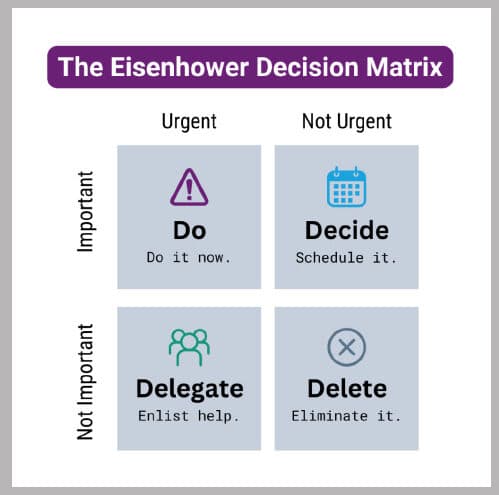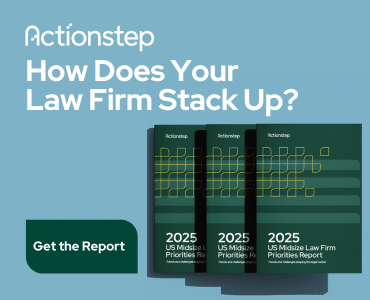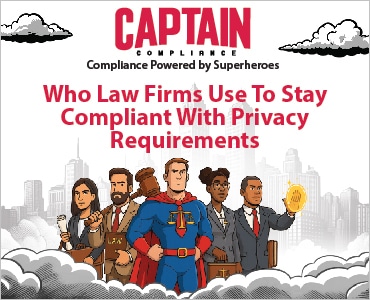As a lawyer, time is one of your most valuable assets — but it’s also a limited resource. In this edition of Ask the Experts at 2Civility.org, Mark C. Palmer tackles effective time management methods for lawyers that can boost productivity while meeting the ethical duty of diligence.
Table of contents
- The Eisenhower Matrix: A Framework for Decision-making
- The ABC Method: Simple Task Prioritization
- Managing Long-Term Tasks
- The Pomodoro Technique
- Ethical Implications of Time Management for Attorneys
- Protect Your Time
- About the Illinois Supreme Court Commission on Professionalism
- More Articles From Mark C. Palmer and 2Civility.org
QUESTION: I’m a new lawyer in my first year at a midsize firm. I’m enjoying the work and have a great mentor, yet I struggle with becoming overwhelmed by deadlines. How should I balance priorities when everything, for every client and partner, seems to be a “top priority”?
ANSWER: As a lawyer, time is one of your most valuable assets —but it’s also a limited resource. Between client meetings, court appearances, research, drafting, and managing your practice, the demands on your work schedule can feel overwhelming. These struggles raise two questions: 1) How should you best prioritize your tasks and 2) how should you best utilize the time allocated to your tasks?
Techniques for prioritizing work, like the Eisenhower Matrix and the ABC Method, provide a structured way to determine what deserves your attention, what can be passed to others, and what can be eliminated.
Once you have prioritized your work, time management methods like the Pomodoro technique can help you stay focused and make real progress.
Remember, effective time management for lawyers is not just about productivity; it is also intertwined with our ethical obligations. Model Rule of Professional Conduct (MRPC) 1.3 establishes the duty of diligence, requiring lawyers to act with reasonable diligence and promptness in representing clients. This rule underscores the importance of managing time effectively to avoid neglecting or unduly delaying client matters, which can lead to client anxiety and undermine trust in the lawyer’s abilities.
Let’s explore how these methods can help you develop an effective time management plan that keeps you organized and focused so you’re working smarter, not just harder.
The Eisenhower Matrix: A Framework for Decision-making
The Eisenhower Matrix is a powerful tool for prioritizing tasks based on urgency and importance. Named after U.S. President Dwight D. Eisenhower, this time management method divides tasks into four quadrants: urgent and important, not urgent but important, urgent but not important, and neither urgent nor important.

Urgent and important tasks, like filing a motion before a deadline, should be addressed immediately. Tasks that are not urgent but still important, such as preparing for an upcoming trial, should be scheduled ahead of time to ensure they aren’t neglected.
Urgent but unimportant tasks, such as responding to noncritical emails, can often be delegated or minimized to free up your time for higher-value work. Finally, tasks that are neither urgent nor important, like excessive social media scrolling, should be eliminated.
One of the key insights of the Eisenhower Matrix is that tasks are not static — they can shift between categories over time as circumstances change. For example, a task that initially falls into the “Not Urgent and Important” quadrant, such as preparing for an upcoming trial, can become “Urgent and Important” as the trial date approaches.
Similarly, tasks in the “Urgent and Not Important” quadrant, like responding to a client’s noncritical email, might escalate to “Urgent and Important” if the issue becomes time-sensitive or impacts a case outcome. Recognizing this fluidity is essential for maintaining an effective prioritization system.
To handle these shifts, it’s important to evaluate your tasks and reassess priorities regularly. Set aside time, maybe daily or weekly, to review your tasks and adjust your focus accordingly.
For tasks that are creeping toward urgency, schedule dedicated time to address them before they become a crisis. Conversely, if a task loses importance or urgency, consider delegating it or removing it from your list entirely. Keep in mind that some tasks involving legal work and legal advice must remain on a lawyer’s to-do list.
The Eisenhower Matrix ensures that you stay ahead of deadlines while focusing on what truly matters, rather than reacting to tasks only when they become urgent.
The ABC Method: Simple Task Prioritization
The “ABC Method” is another effective prioritization technique. It involves assigning tasks a priority level:
- A for high-priority tasks that must be completed today
- B for medium-priority tasks that are important but can wait until higher-priority items are addressed
- C for low-priority tasks that would be nice to complete but aren’t essential
At the start of each day or week, list all your tasks and assign them an A, B or C based on their urgency and importance. Focus on completing all A tasks before moving to B tasks, and only tackle C tasks if time allows.
For instance, you may categorize three items on your to-do list like this:
- Drafting a contract for a new client (A)
- Researching case law for an upcoming appeal (B)
- Reorganizing office files (C)
Using the ABC Method ensures you prioritize drafting the contract over nonessential activities like tidying up your office space. This structured approach prevents less critical tasks from taking up valuable time that should be spent on higher-priority work.
Managing Long-Term Tasks
While prioritization techniques help you manage daily demands effectively, long-term projects present another challenge.
One of the biggest obstacles lawyers face is procrastination on projects with distant deadlines, such as writing a legal brief or preparing for trial. Sometimes these tasks lose your attention until they become emergencies. That’s why setting intermediate deadlines can help you stay on track and avoid last-minute panic.
Breaking down long-term projects into smaller milestones is key to managing them effectively. Start by dividing the project into manageable steps and assigning specific deadlines to each milestone. Use tools like project management software to track your progress, record notes and keep your team on track.
For example, if you’re tasked with drafting an appellate brief due in eight weeks, you might outline key arguments and gather relevant case law in week one, complete the first draft by week three, revise and refine arguments based on feedback from your colleagues by week five, and conduct final edits before submission in week seven.
By setting incremental deadlines, you ensure consistent progress without leaving everything until the last minute.
The Pomodoro Technique
Even when your priorities are set, it can be tempting to juggle multiple responsibilities at once — reading emails during meetings or breaking from your writing to fire off a text. However, research shows that multitasking reduces efficiency and increases mistakes.
Monotasking involves focusing on one task at a time during dedicated work blocks. The Pomodoro Technique is an excellent way to implement monotasking by breaking work into 25-minute sprints followed by 5-minute breaks. To use this method effectively, choose a task to focus on exclusively for 25 minutes and set a timer (a physical Pomodoro timer works wonders). Work without interruptions until the timer rings, then take a short break before starting another sprint.
For example, if you are drafting a complex contract, focus on drafting that contract only for 25 minutes, closing all other programs, silencing your phone, and otherwise blocking out all distractions.
After 25 minutes of uninterrupted work, take a five-minute break, like getting up from your desk and stretching. After four cycles, take a break to check in on emails and other matters.
This focused approach allows you to immerse yourself in a task while minimizing interruptions, hopefully producing a better work product.
Ethical Implications of Time Management for Attorneys
Developing good time management habits takes practice and discipline. It is also an ethical obligation under the Rules of Professional Conduct.
MRPC 1.3 emphasizes that lawyers must act with reasonable diligence and promptness in representing their clients. Effective time management ensures you meet deadlines consistently while providing competent representation without unnecessary delays or oversights. Not only is it good customer service, it’s an ethical duty.
Protect Your Time
To stay consistent with your plan, spend 10 minutes at the end of each day reviewing your schedule and setting priorities for the next day.
Use technology wisely by leveraging project management tools such as Monday.com, Asana, Trello or even your online calendar to organize tasks and set reminders. Protect your time by saying no to requests that don’t align with your priorities. Finally, reflect weekly on what worked and areas that need improvement.
Time management isn’t just about getting more done, it’s about focusing on what matters most while maintaining balance. Techniques like the Eisenhower Matrix and the ABC Method can help you prioritize effectively, maximizing the value you offer clients.
As lawyers, we often feel like there aren’t enough hours in the day. With a practical plan in place, we can make every hour count.
About the Illinois Supreme Court Commission on Professionalism
The Illinois Supreme Court established the Commission on Professionalism under Supreme Court Rule 799 to promote integrity, professionalism, and civility among the lawyers and judges of Illinois, to foster a commitment to the elimination of bias and divisiveness within the legal and judicial systems, and to ensure those systems provide equitable, effective, and efficient resolution of problems for the people of Illinois. The Commission achieves this mission through professional responsibility CLE, lawyer-to-lawyer mentoring, legal professionalism programming, educational resources, and more. To learn more, visit 2Civility.org and follow us on social media.
Illustration ©iStockPhoto.com
More Articles From Mark C. Palmer and 2Civility.org
- Generative AI for Lawyers: From Fear to Functionality, How Lawyers Can Ethically Integrate AI into Their Practice
- Be Reasonable, People! AI’s Impact on Legal Fees
- How Lawyers Can Use Code Words to Combat Client Voice Cloning and Deepfakes
- Ethical Options for Responding to Negative Online Attorney Reviews
- Harnessing ChatGPT: A Primer for Lawyers
- Should Lawyers Be Using Email Encryption?
- Ethical Pitfalls When Using ChatGPT
- Can Lawyers Ethically Store and Transmit Client Info in the Cloud?
- Ethical Considerations for Flat Fee Billing
- Leaving Your Firm? Aim for a Joint Notice to Clients
- Ethics Reminders for Lawyers Texting Clients
- Ethical Considerations of Legal Chatbots
















